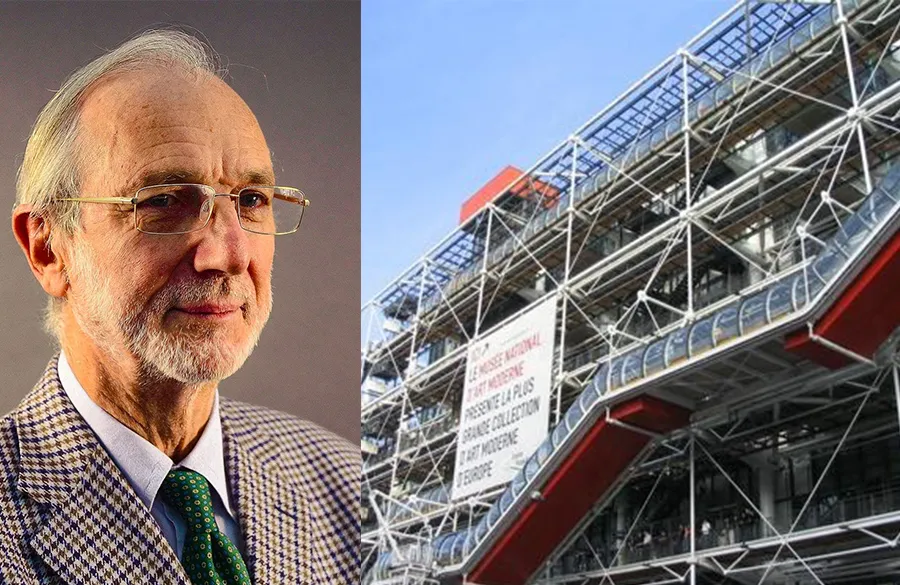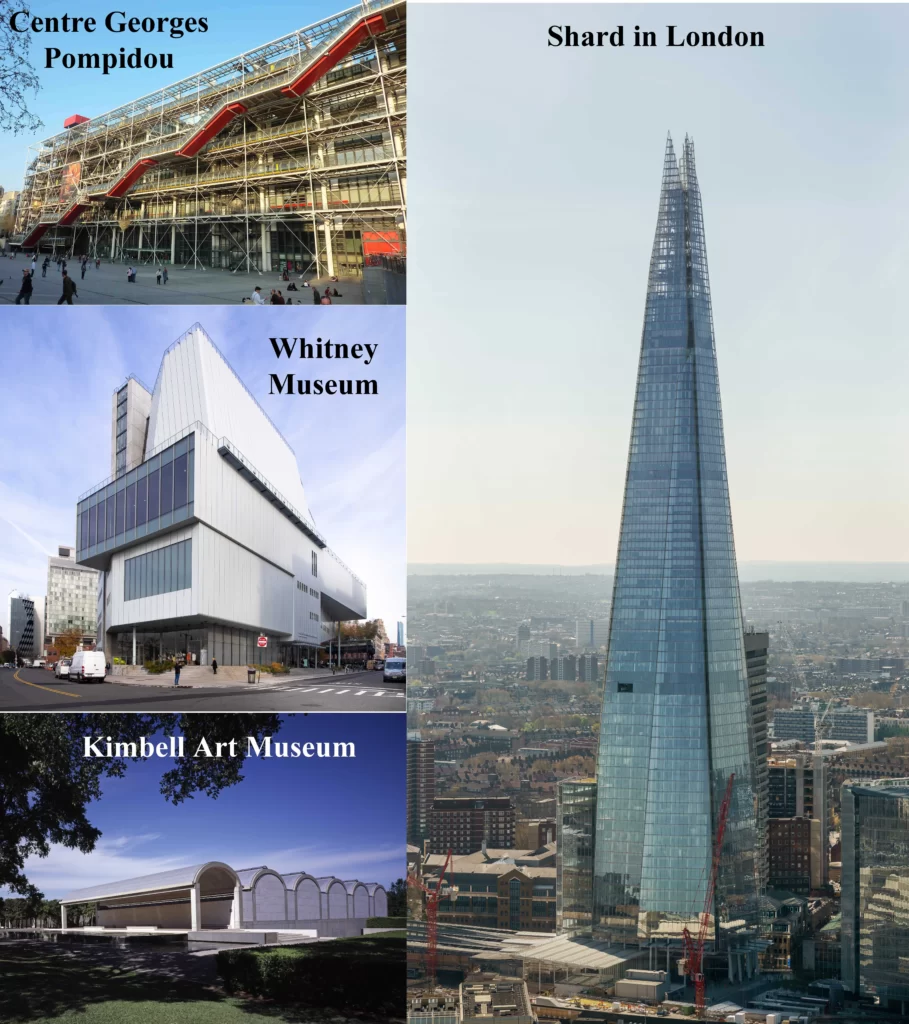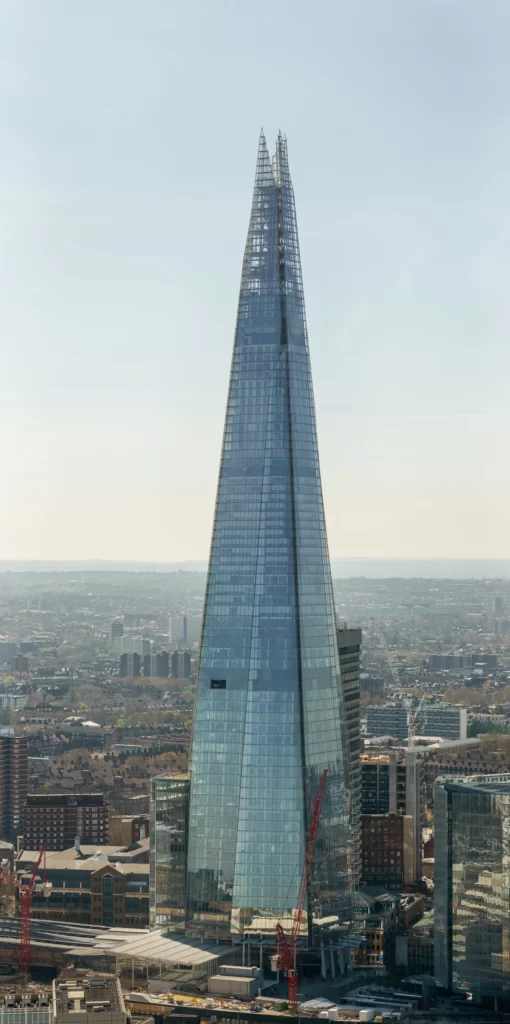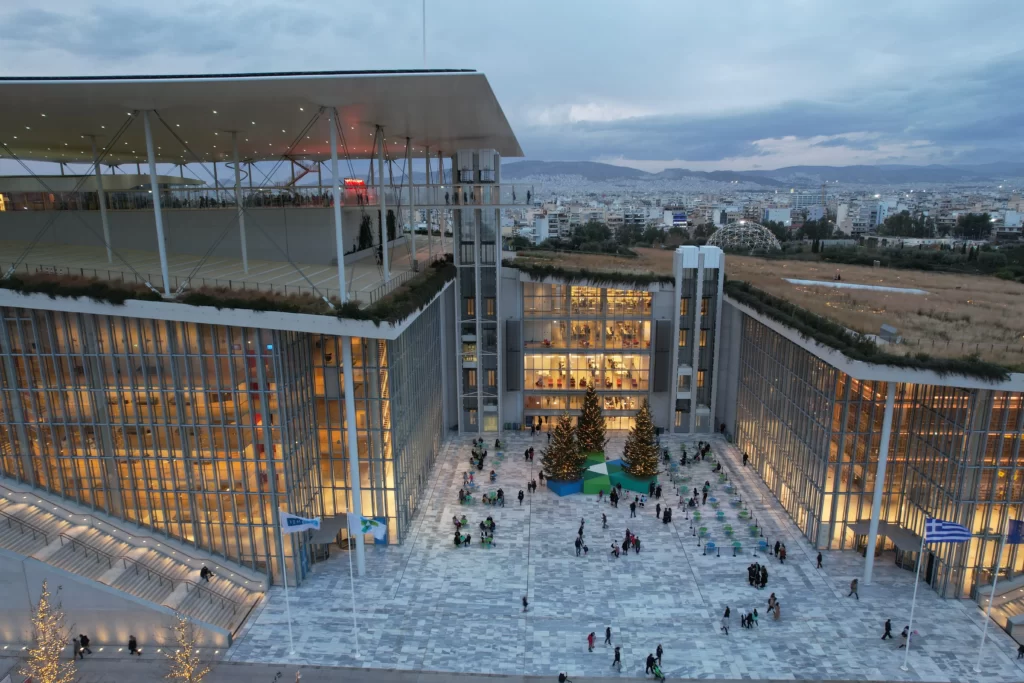If you want to know about the staircase design or landscape garden or requirements for disabled persons in a building, please click the link.
Introduction
Renzo Piano is an Italian architect born in Genoa, Italy, in 1937. He is one of the most renowned and influential architects of the 20th and 21st centuries, known for his innovative designs, commitment to sustainability, and collaborations with other prominent architects and artists.

Piano’s career began in the early 1960s when he worked with Louis Kahn and Z.S. Makowski in Philadelphia. He then returned to Italy to establish his own architectural firm, which eventually became Renzo Piano Building Workshop (RPBW) in 1981. Over the years, Piano has designed numerous iconic buildings around the world, such as the Centre Georges Pompidou in Paris, the Shard in London, the Whitney Museum of American Art in New York, and the Kimbell Art Museum in Fort Worth, Texas.

Piano is also known for his commitment to sustainable design, as evidenced by his works such as the California Academy of Sciences in San Francisco and the International Terminal at San Francisco International Airport.


He has received numerous awards and honors for his contributions to architecture, including the prestigious Pritzker Architecture Prize in 1998.
1) Early Life and Education
Renzo Piano was born on September 14, 1937, in Genoa, Italy. His family was involved in the construction industry, and Piano grew up surrounded by architects, engineers, and builders. This exposure to the world of construction and design from an early age sparked his interest in architecture.
Piano studied at the Politecnico di Milano University, where he graduated with a degree in architecture in 1964. He then worked with several notable architects, including Louis Kahn in Philadelphia and Franco Albini in Milan. In 1971, he founded his own architectural firm, Studio Piano & Rogers, with Richard Rogers, which led to the design of the Centre Georges Pompidou in Paris, one of Piano’s most famous works.
Piano’s work has been influenced by a variety of factors, including his upbringing in a family of builders and his education at the Politecnico di Milano. He has also cited the work of architects such as Le Corbusier, Louis Kahn, and Carlo Scarpa as significant influences on his own design philosophy.
Additionally, Piano’s collaborations with other prominent architects and artists, such as Richard Rogers and Cy Twombly, have also had an impact on his work. Finally, Piano’s commitment to sustainability and innovative design has also influenced his approach to architecture.
2) Notable Works
Renzo Piano has designed many notable works over the course of his career, including:
Centre Georges Pompidou, Paris, France

The Centre Georges Pompidou in Paris, France is a modern art museum and cultural center known for its distinctive “inside-out” design, with colorful pipes and ducts visible on the exterior.
The Shard, London, UK

The Shard is a 95-story skyscraper in London, UK, designed by architect Renzo Piano. It is the tallest building in the United Kingdom and features a mix of office space, luxury apartments, restaurants, and observation decks with views of the city.
Whitney Museum of American Art, New York City, USA

The Whitney Museum of American Art in New York City is a modern and contemporary art museum designed by architect Renzo Piano. The building features a series of outdoor terraces and overlooks the High Line park, and its galleries showcase a diverse collection of American art from the 20th and 21st centuries.
Kimbell Art Museum, Fort Worth, Texas, USA

The Kimbell Art Museum in Fort Worth, Texas is an art museum designed by architect Renzo Piano. Its building features a series of parallel pavilions with natural light and a spacious central courtyard. The museum’s collection includes European masterpieces and contemporary art, and it hosts special exhibitions and events.
California Academy of Sciences, San Francisco, USA

The California Academy of Sciences in San Francisco is a natural history museum and research institution designed by architect Renzo Piano. Its building features a living roof with native plants, an aquarium, a planetarium, and exhibits on biodiversity, ecology, and sustainability. The museum also hosts educational programs and events.
Parco della Musica Auditorium, Rome, Italy

The Parco della Musica Auditorium in Rome is a concert hall complex designed by architect Renzo Piano. The complex features three separate concert halls with state-of-the-art acoustics, as well as outdoor spaces and public areas for events and exhibitions. It is home to the Orchestra dell’Accademia Nazionale di Santa Cecilia.
Stavros Niarchos Foundation Cultural Center, Athens, Greece

The Stavros Niarchos Foundation Cultural Center in Athens is a cultural complex designed by architect Renzo Piano. The center features a large park, a performance hall, a library, and a national opera house. Its buildings are designed for sustainability and energy efficiency, and it hosts a wide range of cultural events and activities.
Harvard Art Museums, Cambridge, Massachusetts, USA

The Harvard Art Museums in Cambridge, Massachusetts is an art museum designed by architect Renzo Piano. The building features a glass roof and an open-plan design, with galleries showcasing the museum’s extensive collection of European and American art, as well as Asian, Middle Eastern, and contemporary art. The museum also hosts exhibitions and educational programs.
The New York Times Building, New York City, USA

The New York Times Building is a skyscraper in New York City designed by architect Renzo Piano. The building features a unique exterior of ceramic rods and energy-efficient glass, as well as an open-plan newsroom and offices for the newspaper’s staff. It is a symbol of the newspaper’s commitment to journalism and innovation.
The Menil Collection, Houston, Texas, USA

The Menil Collection in Houston, Texas is an art museum designed by architect Renzo Piano. Its building features natural light and a simple, modern design, with galleries showcasing the museum’s collection of art from ancient to modern times, including works by Picasso, Warhol, and Rothko. The museum also hosts special exhibitions and events.
Centre Georges Pompidou is one of Piano’s most famous works. Completed in 1977, it is an iconic building that is widely recognized for its innovative design, which features an exposed steel and glass structure, brightly colored pipes and ducts, and an open public plaza in front of the building.
The Shard is another landmark building designed by Piano. Completed in 2012, it is the tallest building in Western Europe and is known for its striking glass facade and innovative use of sustainable materials.
The Whitney Museum of American Art is a recent addition to Piano’s portfolio, completed in 2015. The building’s design is inspired by the industrial character of the surrounding neighborhood, and it features a series of cantilevered galleries that offer panoramic views of the city.
Piano’s works have been widely recognized and awarded, including the Pritzker Architecture Prize in 1998, the Royal Gold Medal from the Royal Institute of British Architects in 1989, and the RIBA Stirling Prize in 2003 for the design of the Menil Collection.
Several of his works have also been designated as UNESCO World Heritage Sites, including the Centre Georges Pompidou and the Piazza del Duomo in Pisa, Italy, which Piano helped to restore in the 1990s.
3) Design Philosophy
Renzo Piano’s design philosophy is rooted in a belief in the power of architecture to shape people’s lives and experiences. He sees architecture as a way to create spaces that are both functional and beautiful, and that enhance the well-being of the people who use them. He is also committed to sustainable design, and often incorporates environmentally-friendly features into his buildings.
Piano’s design philosophy is reflected in many of his works, such as the California Academy of Sciences, which incorporates a living roof that helps to reduce energy use, and the Stavros Niarchos Foundation Cultural Center, which features a rainwater harvesting system and a green roof.
In addition to sustainability, Piano’s works often feature a sense of openness and transparency, with large windows and open spaces that encourage interaction and community.
Piano’s design philosophy can be compared to that of other prominent architects, such as Frank Lloyd Wright, who also believed in the importance of integrating buildings with their natural surroundings, and Le Corbusier, who emphasized the importance of functional design and the use of modern materials.
However, Piano’s approach is distinct in its emphasis on sustainability and his belief that architecture can have a positive impact on people’s lives.
Other architects, such as Zaha Hadid and Frank Gehry, have also pushed the boundaries of traditional architecture and experimented with new forms and materials, but Piano’s approach is often more restrained and focused on creating buildings that are both beautiful and functional.
4) Collaborations and Partnerships
Renzo Piano has collaborated with a number of prominent architects, artists, and engineers over the course of his career. These partnerships have been instrumental in shaping his work and pushing the boundaries of what is possible in architecture.
Piano’s collaborations have had a significant impact on his work, allowing him to experiment with new materials and techniques, and to bring a wider range of perspectives to his design process.
He has worked closely with engineers and construction experts, such as Peter Rice, to create innovative structures that are both beautiful and functional. He has also collaborated with artists, such as Cy Twombly, to create buildings that incorporate works of art into their design.
Some notable projects resulting from Piano’s collaborations include:
- Centre Georges Pompidou, Paris, France – designed in partnership with Richard Rogers
- The Shard, London, UK – designed in partnership with William Matthews
- Parco della Musica Auditorium, Rome, Italy – designed in partnership with Arup Engineering and sound designer Yasuhisa Toyota
- Kimbell Art Museum, Fort Worth, Texas, USA – designed in partnership with landscape architect Peter Walker and art conservator Gianfranco Pocobene
- Whitney Museum of American Art, New York City, USA – designed in partnership with Cooper Robertson & Partners
Each of these projects represents a unique collaboration between Piano and other experts in the field, resulting in buildings that are both functional and beautiful, and that push the boundaries of what is possible in architecture.
5) Sustainability and Innovation
Renzo Piano is committed to sustainable design and believes that architects have a responsibility to create buildings that minimize their impact on the environment. He has been a leader in the green building movement, and has worked to incorporate sustainable design principles into many of his projects.
Piano incorporates sustainability into his works in a number of ways, including through the use of renewable energy sources, such as solar and wind power, the incorporation of green roofs and walls, the use of natural ventilation and daylighting, and the use of sustainable materials, such as bamboo and recycled materials. He also focuses on designing buildings that are energy efficient and that can operate with minimal impact on the environment.
Piano’s works often incorporate innovative technologies and materials that help to reduce their environmental impact. For example, the California Academy of Sciences, which he designed, features a living roof that helps to reduce energy use and provides habitat for native plants and animals.

The Stavros Niarchos Foundation Cultural Center, which he also designed, features a rainwater harvesting system and a green roof that helps to reduce water use and energy use.

In addition, Piano has experimented with the use of new materials, such as transparent photovoltaic glass, which can generate electricity while still allowing natural light to enter a building.
Piano has also been a leader in the development of sustainable design standards, such as the LEED (Leadership in Energy and Environmental Design) certification system.
Many of his projects have been awarded LEED certifications, demonstrating his commitment to sustainable design and his belief in the importance of creating buildings that are both beautiful and environmentally responsible.
6) Legacy and Impact
Renzo Piano has had a lasting impact on the field of architecture, both through his innovative designs and his commitment to sustainability. His work has helped to redefine the role of the architect in society, and has inspired a new generation of designers to prioritize sustainability and social responsibility in their work.
Piano’s work has also had a significant influence on other architects and architecture trends. His emphasis on the use of innovative materials and technologies, such as photovoltaic glass and green roofs, has become increasingly common in contemporary architecture. His emphasis on creating buildings that are both functional and aesthetically pleasing has also influenced a number of other architects.
In addition, Piano’s focus on collaboration and interdisciplinary partnerships has become a model for other architects and designers, helping to break down traditional silos and encourage new approaches to problem-solving in the field of architecture.
It is likely that Piano’s work will continue to influence architecture in the future, particularly as sustainability becomes an increasingly important issue for architects and designers. His emphasis on creating buildings that are energy efficient and environmentally responsible is likely to become even more important as climate change and resource depletion become more pressing issues.
Piano’s legacy also includes his commitment to social responsibility, and his belief in the power of architecture to shape society and improve people’s lives. This focus on creating buildings that are not only functional, but that also contribute to the well-being of their communities, is likely to become an even more important focus for architects in the future.
Overall, Piano’s work has helped to redefine the role of the architect in society, and has paved the way for a more sustainable, collaborative, and socially responsible approach to architecture in the future.
7) Conclusion
Renzo Piano has made significant contributions to the field of architecture throughout his career. He has designed numerous iconic buildings around the world, and his commitment to sustainability and social responsibility has helped to redefine the role of the architect in society. Piano’s work has also influenced other architects and architecture trends, and his focus on collaboration and interdisciplinary partnerships has become a model for designers across disciplines.
Piano’s impact and legacy are likely to endure for years to come, as sustainability and social responsibility continue to be important issues for architects and designers. His innovative designs, commitment to sustainability, and focus on creating buildings that are both functional and aesthetically pleasing have inspired a new generation of architects and helped to shape the future of the field.
Readers interested in learning more about Renzo Piano’s work and its impact on architecture are encouraged to explore his portfolio, as well as the works of other architects and designers who have been influenced by his approach. By continuing to explore and engage with innovative and sustainable design practices, we can help to build a more sustainable, equitable, and beautiful world for generations to come.